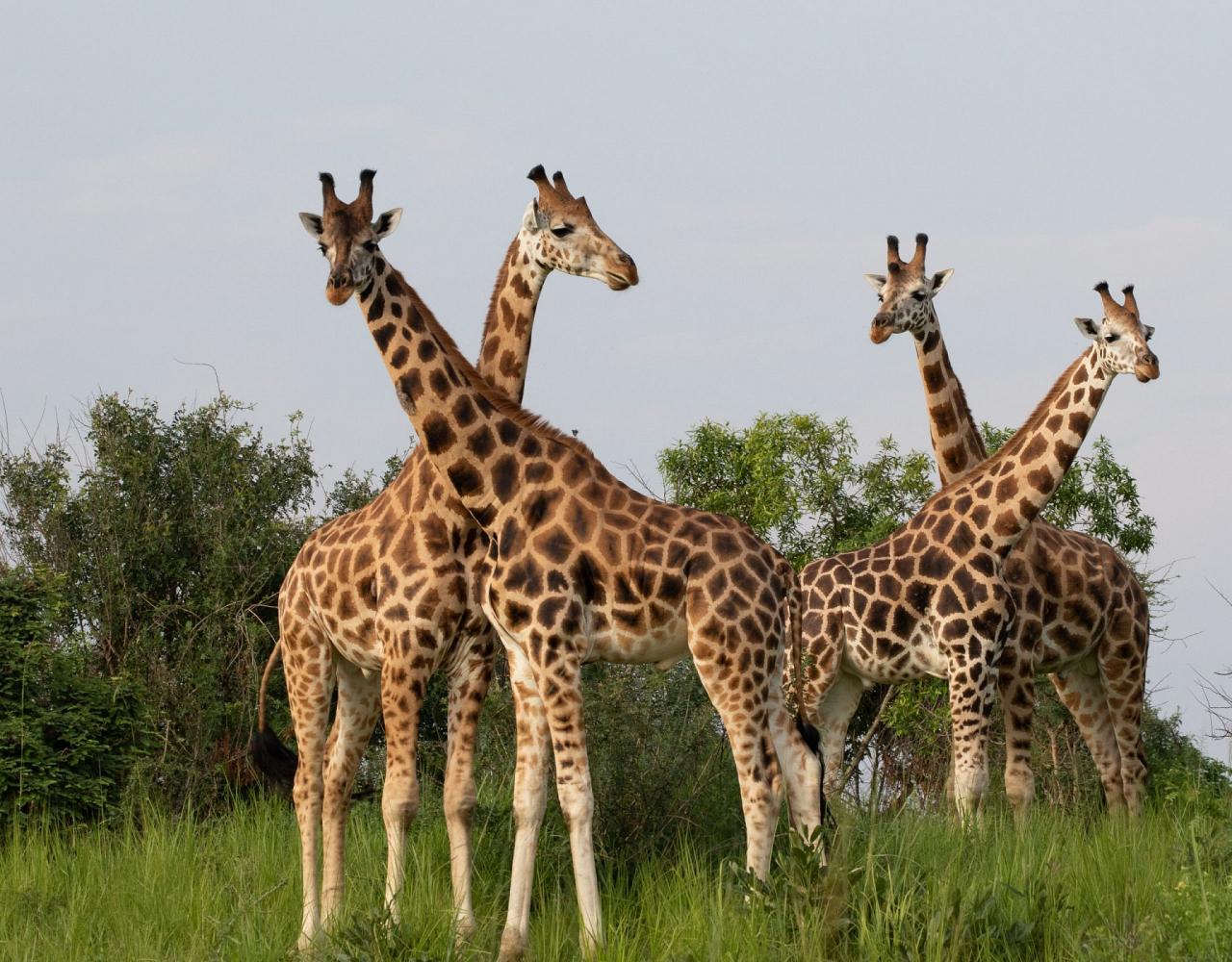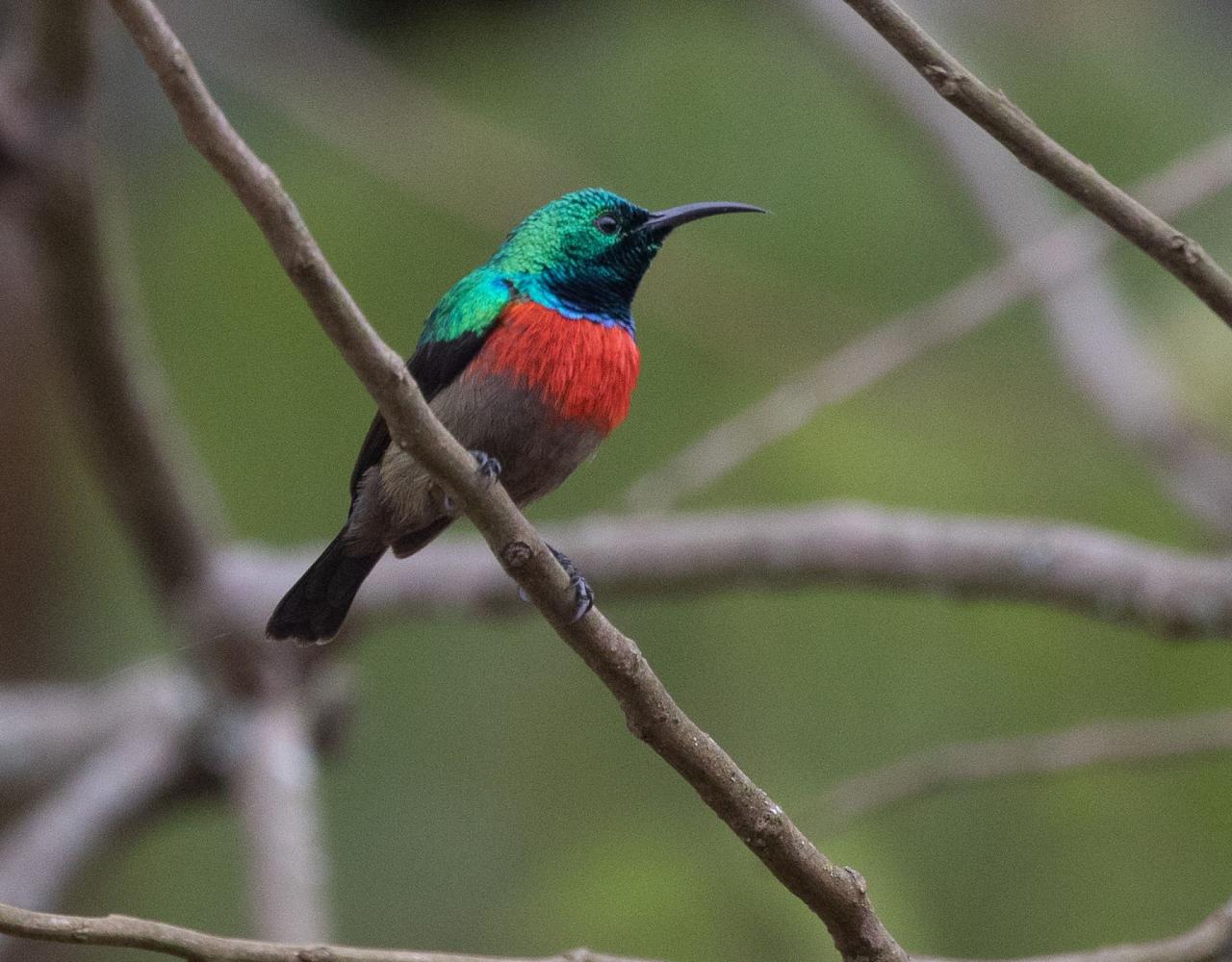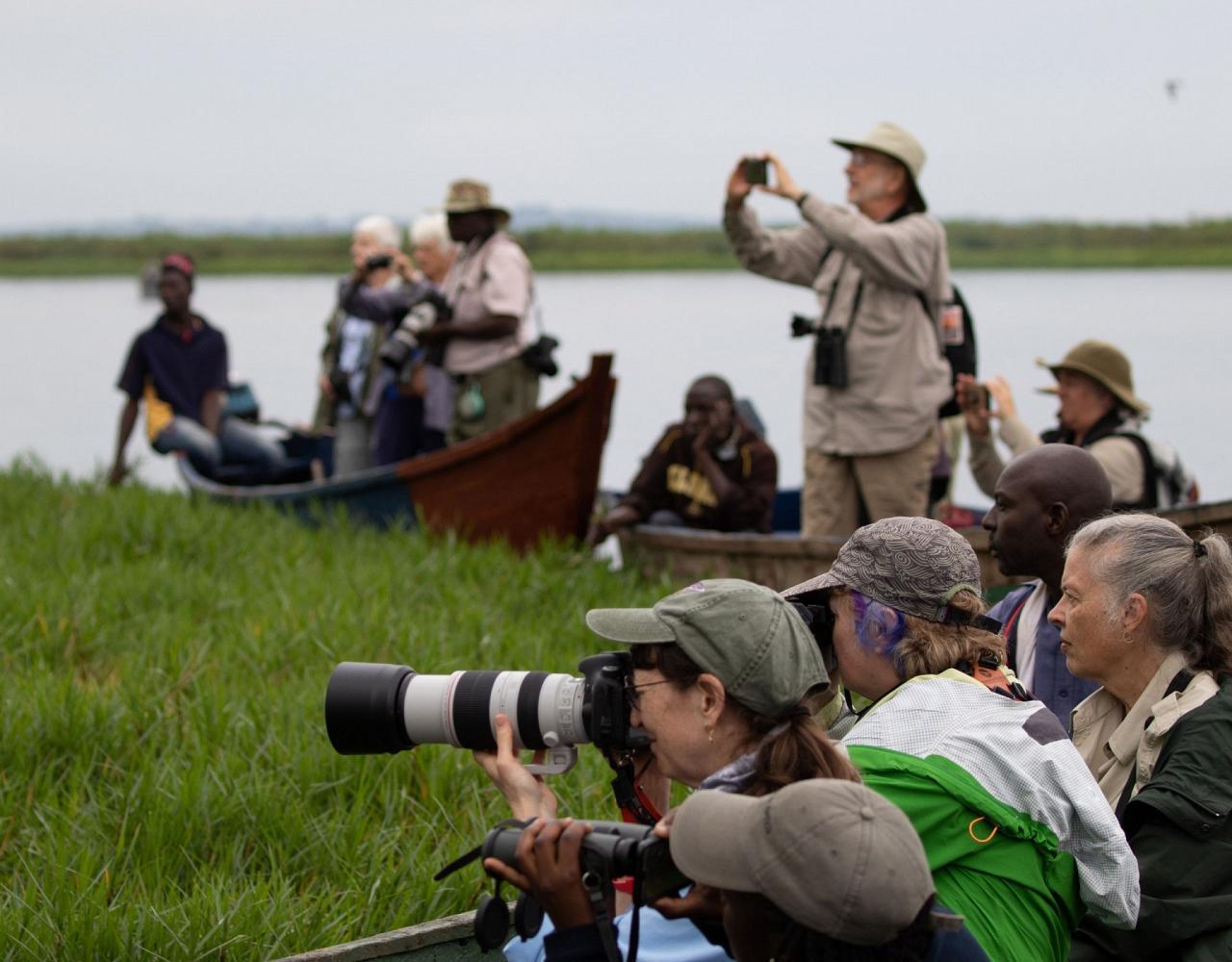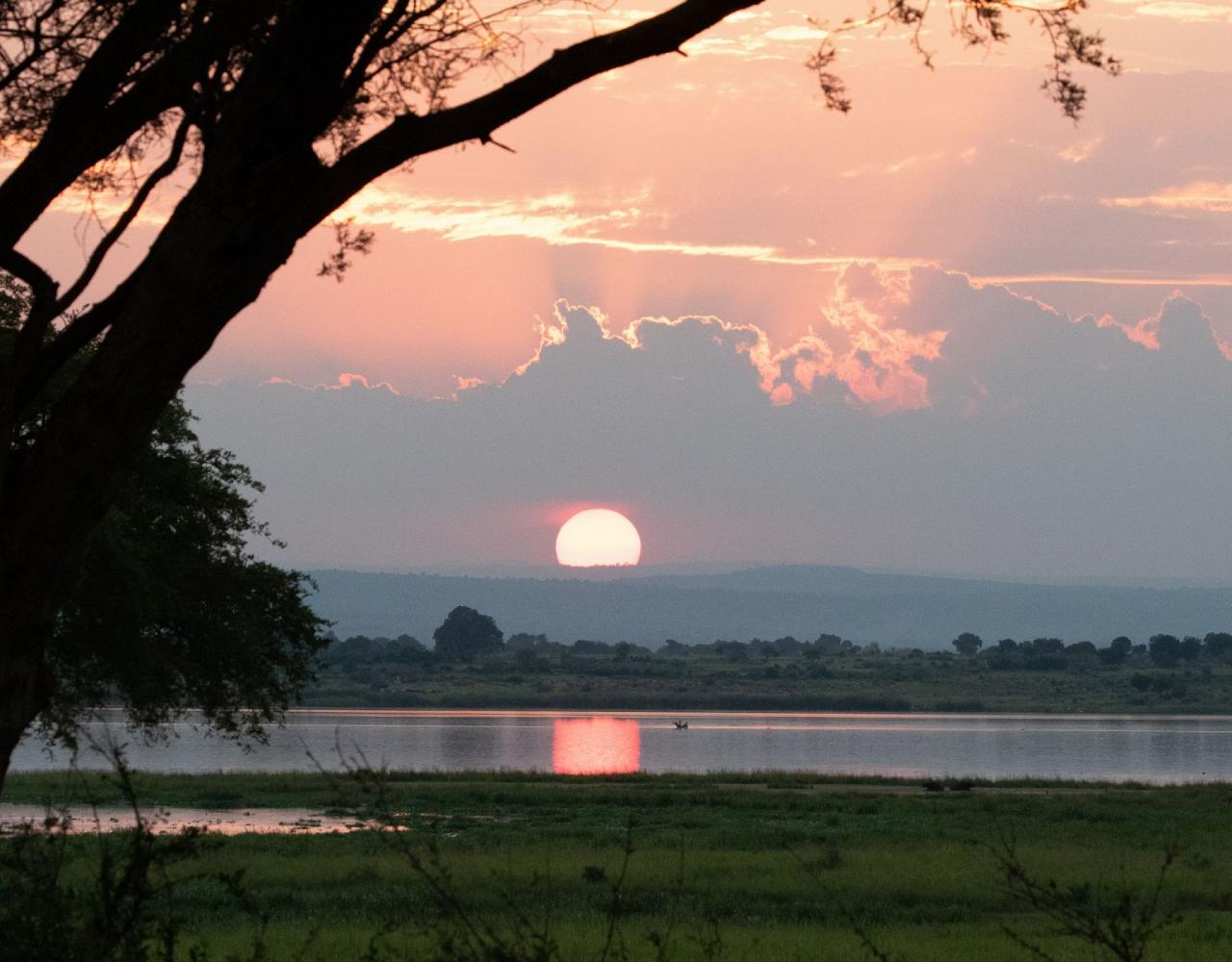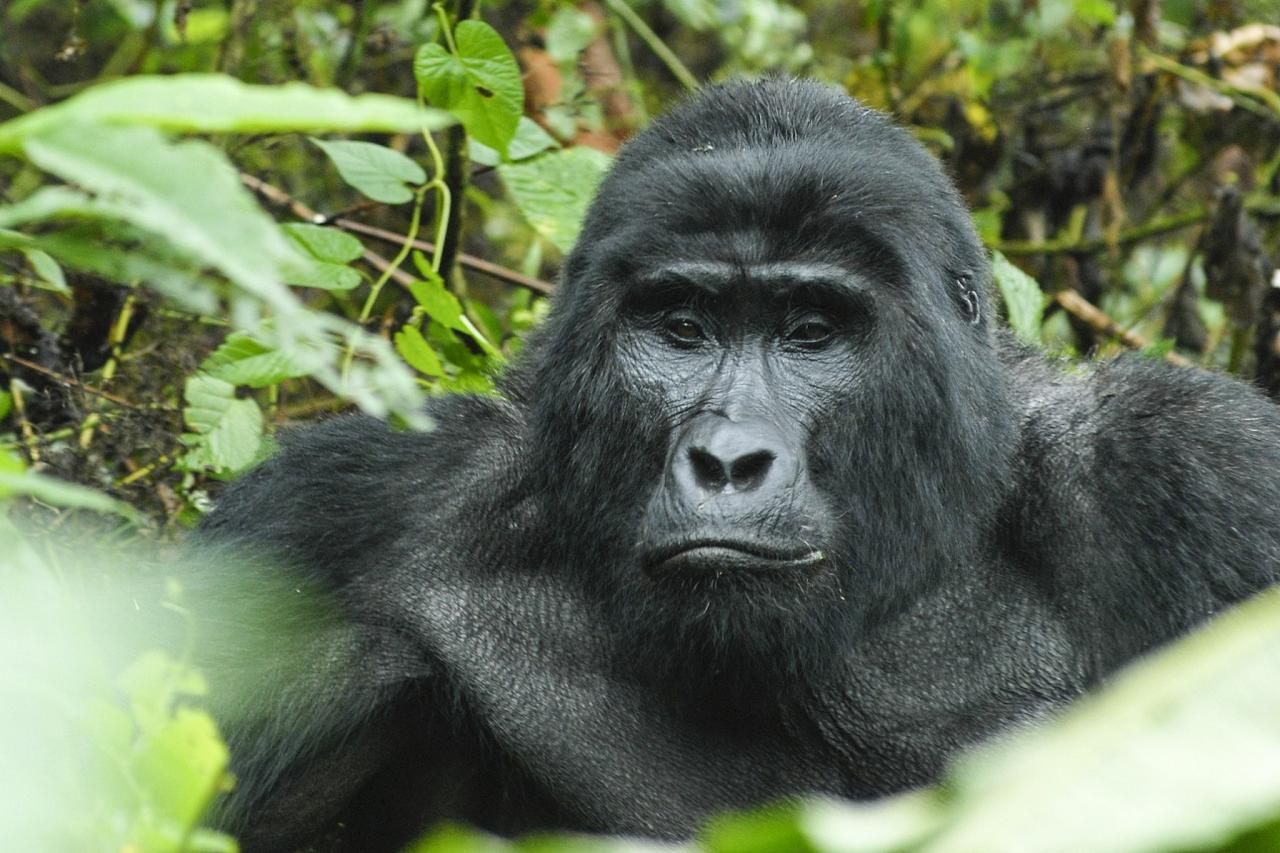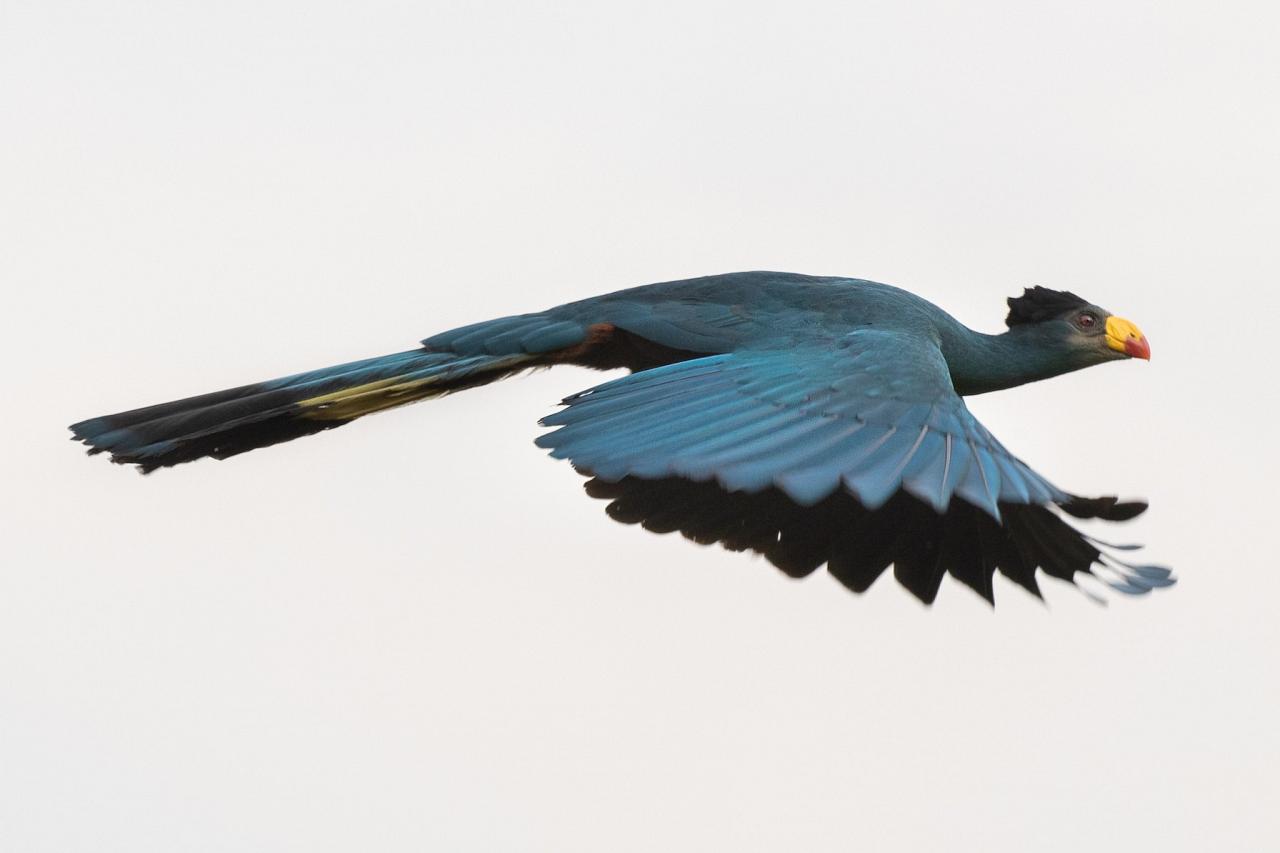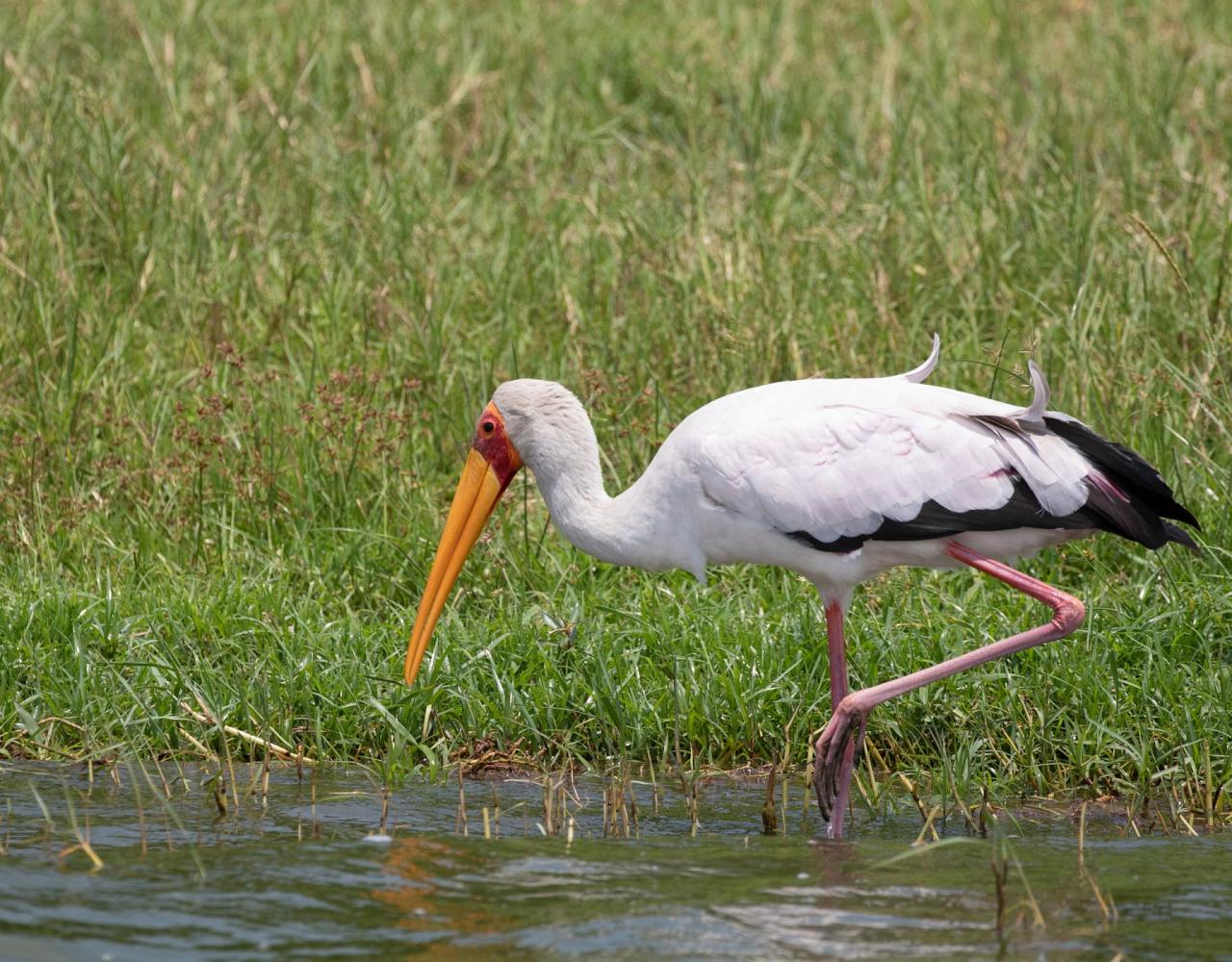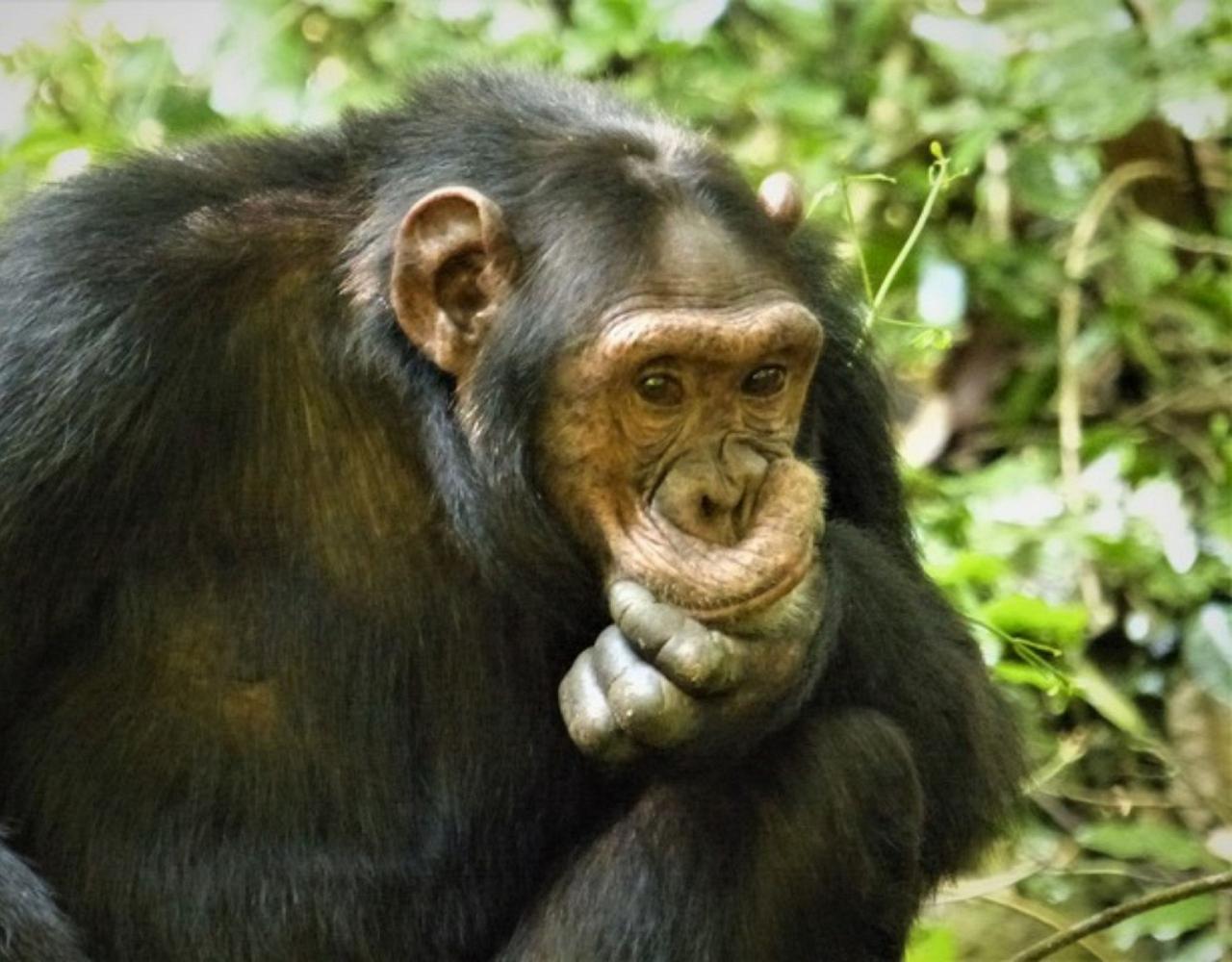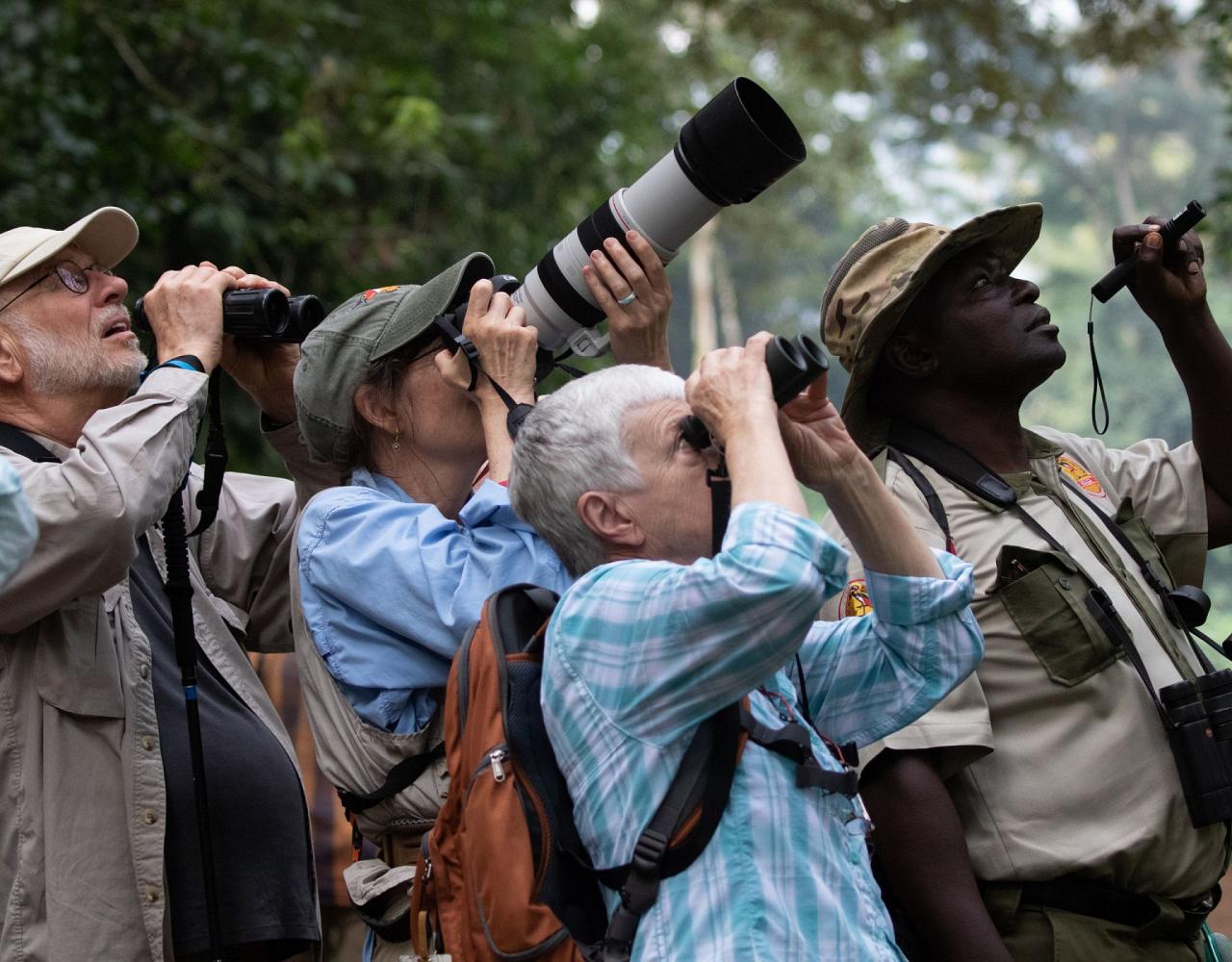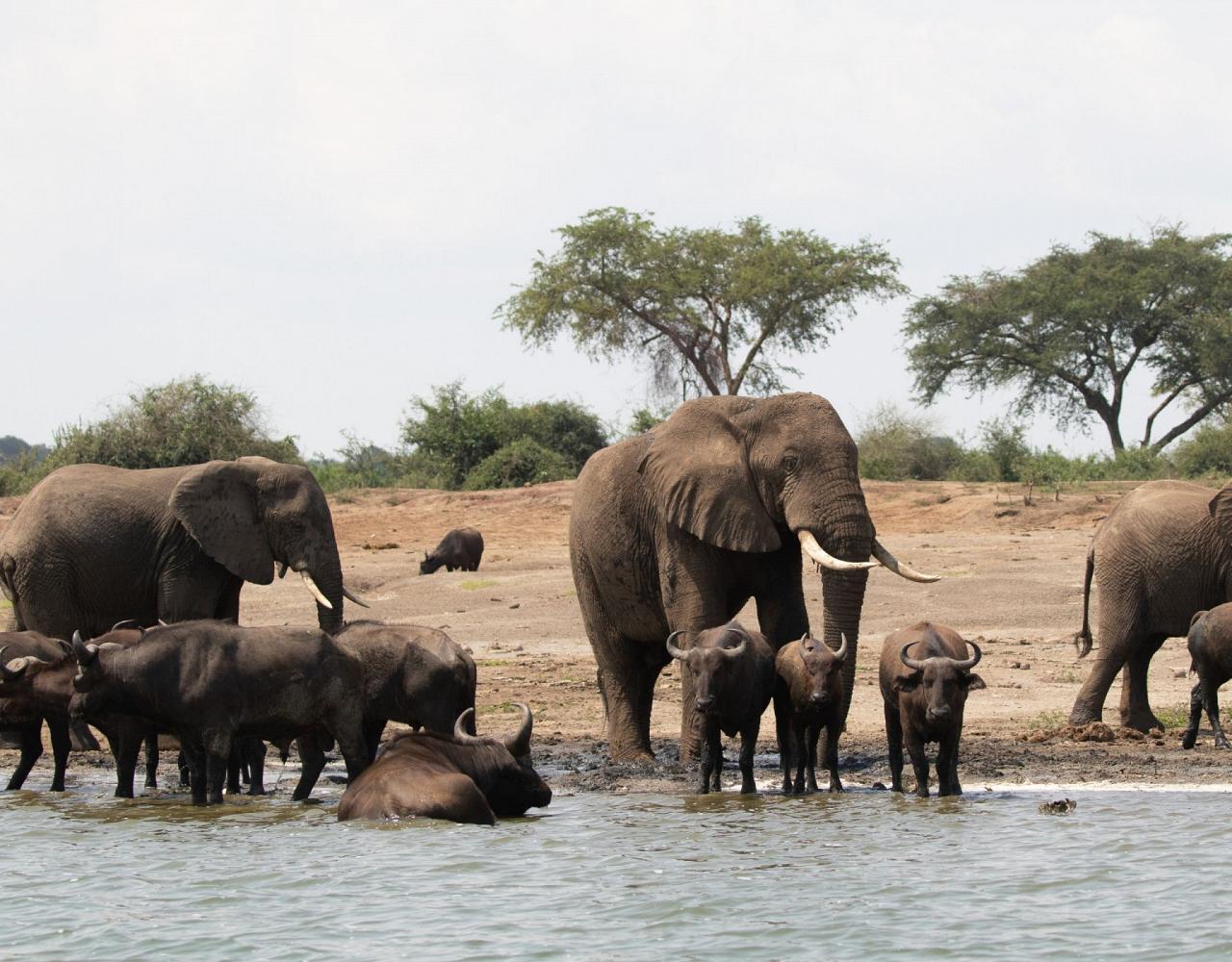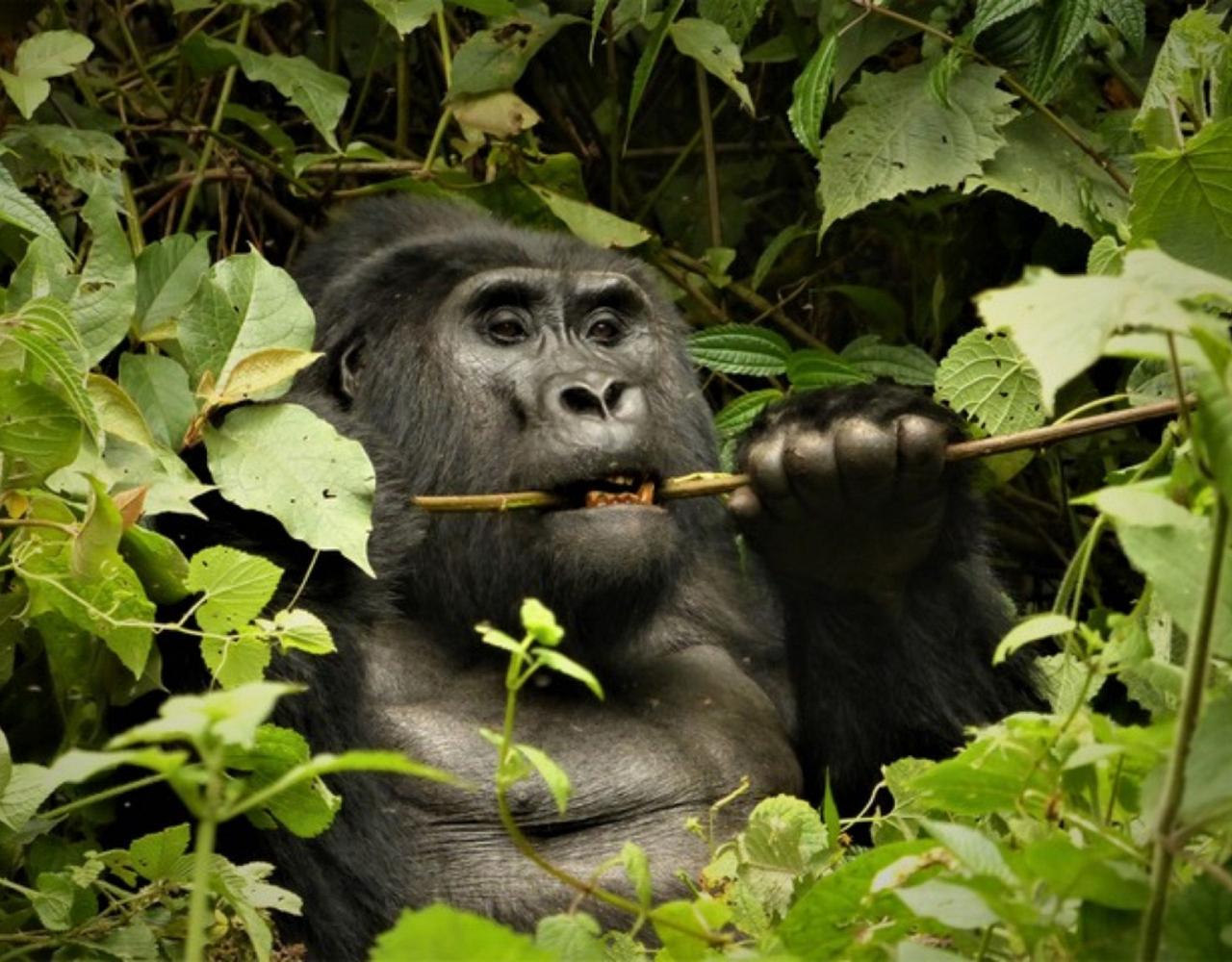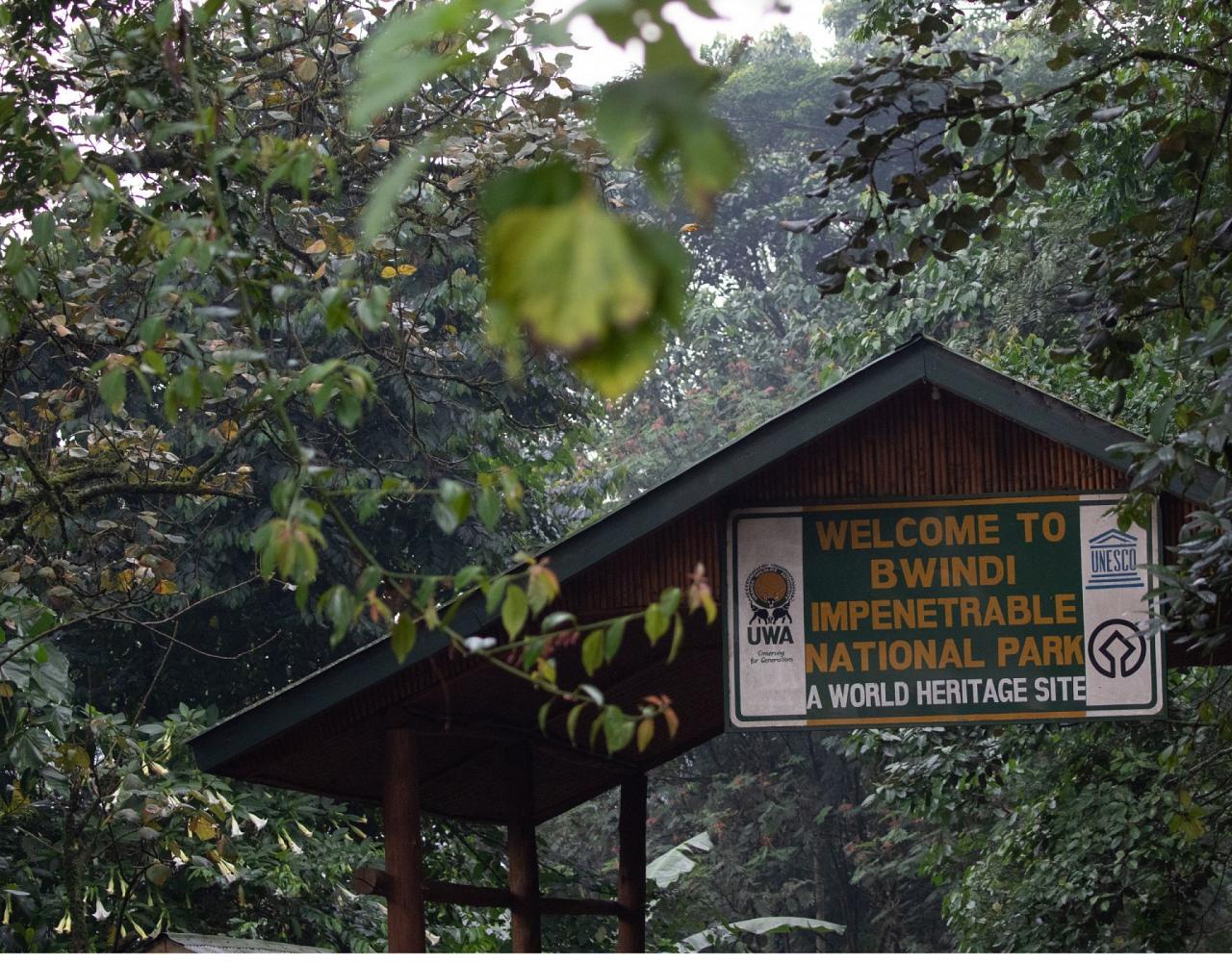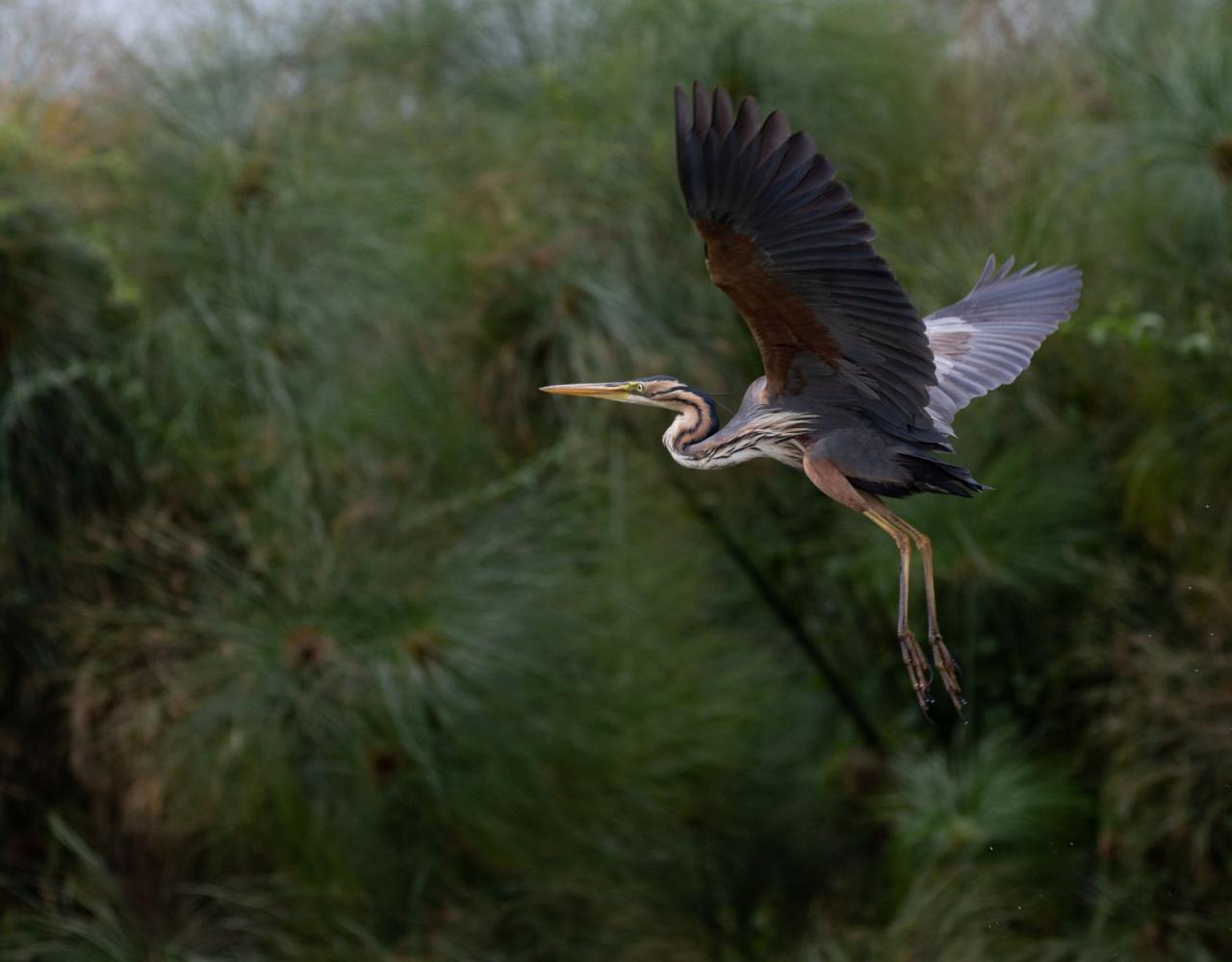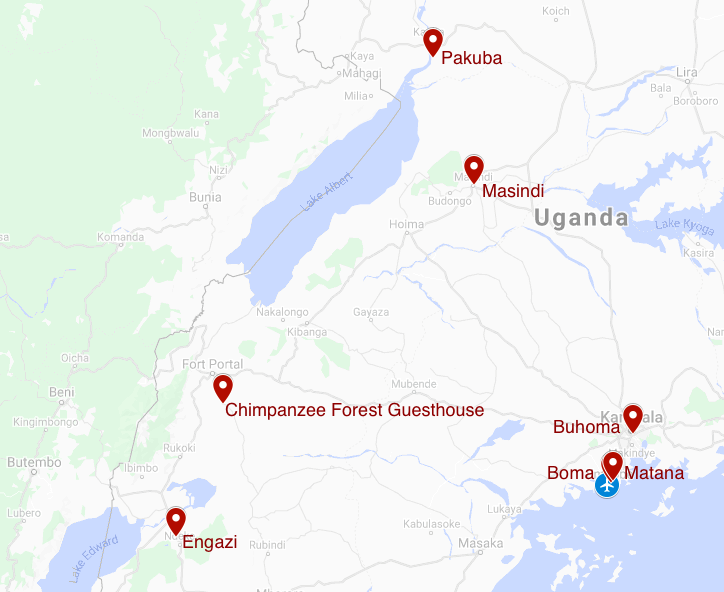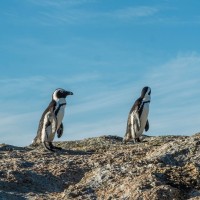- Overview
- Full Itinerary
- Photo Gallery
- Costing
- Travel Details
- Trip Reports
- Guide
- Map
- Know Before You Go
- Other Trips You May Like
Join Naturalist Journeys on this exciting Uganda birding and nature adventure. Uganda is fast gaining fame as a wonderful place to explore Africa, hosting a rich geography of wetlands, savannas, and montane rainforests associated with the Albertine Rift, a high plateau where Africa’s great rivers are born and 20+ endemic bird species can be found. From the shores of Lake Victoria to lush forests skirting the beautiful Virunga Volcanos, Uganda hosts both a rich bird and mammal fauna. It is a fascinating blend that we explore through a classic African safari with game drives. We also spend time exploring some of the best forests remaining on the continent; Uganda’s wild forest reserves are home to myriad beautiful birds, rare Mountain Gorilla, Chimpanzee, and other primates. The Gorilla and Chimpanzee treks on this trip are optional, but highly recommended!
Your tour supports Uganda Women Birders, and one of their guide trainees will join our group and expert local guide. We are thrilled to be able to help continue field training for these exceptional young women.
For this tour, bird and butterfly expert Robert Gallardo joins our group as we explore the nearly 1200 species of butterflies that call Uganda home.

- *Great trip, not only saw lots of birds but also Gorilla, Chimpanzee and other large and small mammals. Our guide was wonderful, very knowledgeable and took care of all our issues…Highlights include the number of birds we saw, total of 288 species including the rare Shoebill! (Uganda is a) country with very warm people welcoming visitors, rich in bird life especially around lakes and rivers.” — Nancy Siepman, 2023 Traveler
- "Amazing, incredible, the trip of a lifetime. It was a dream come true." — Elizabeth Trimble, 2023 Traveler
- “A lovely introduction to the country of Uganda - including wildlife and birds” — 2023 Traveler
Tour Highlights
- Explore the labyrinth of lagoons of Mabamba Swamp by canoe in search of Uganda’s iconic Shoebill
- Enjoy a game drive in Lake Mburo NP for views of Zebra, Impala, Eland, Topi, African Buffalo, and more
- See some of Africa’s most beautiful birds: turacos, barbets, bushshrikes, bee-eaters, and broadbills
- Enter Bwindi’s Impenetrable Forest NP, a UNESCO World Heritage Site, home to approximately half the world’s endangered population of Mountain Gorilla
- Discover Bwindi’s productive montane forest birding along the mountain spine of Africa—lush forests support 23 of Uganda's 24 Albertine Rift endemic birds
- Visit Queen Elizabeth National Park on the Equator in search of Elephant, Spotted Hyena, Leopard, Lion, Ugandan Kob, Side-striped Jackal, Baboon, and other mammals, as well as abundant birds
- Take an exciting boat cruise on the Kazinga channel for excellent sightings and photo opportunities of wading birds and abundant Hippopotamus
- Find out why Kibale Forest National Park is the best safari destination for Chimpanzee tracking in East Africa, a place where up to 13 species of primates can be seen (and the bird list is 325 species!)
- Discover Murchison Falls, a stunning end tour our tour!
Trip Itinerary
Itineraries are guidelines; variations in itinerary may occur to account for weather, road conditions, closures, etc. and to maximize your experience.
Tues., July 7 Arrive in Entebbe, on the Shore of Lake Victoria
Several major airlines provide service to Entebbe, including United, Delta, Emirates, Ethiopian, KLM, and others. Typical stops en route include your gateway through Brussels, Amsterdam, Nairobi, Addis Ababa, Doha, or Kigali. Note, you need to leave the day prior to arrival, July 8 departing the USA. If you wish to combine with another part of Africa, then Kenya or Ethiopia work well and in both we have partner companies that can provide guided custom excursions.
Today is planned as just a day of rest; for those arriving in time we gather for a welcome dinner at our hotel. For those that arrive early in the day, you can rest and enjoy birding on the grounds. The hotel is close to the airport, and provides dependable and convenient shuttle service.
For those who come in early, you have the option to join a guided botanic garden tour today.
Accommodations at the Boma Hotel, Entebbe (D)
Wed., July 8 Botanic Garden Birding & Local Hotspots
We take our time this morning, birding our hotel grounds and generally situating ourselves to the time zone and new birds. We explore local patches and enjoy an exploration of the local botanic gardens with our guide. Trails are well-manicured and easy for walking and birding.
Accommodations at the Boma, Entebbe (D)
Thurs., July 9 Mabamba Swamp | Lake Mburo National Park
After an early breakfast, we proceed to the Mabamba Swamp, a Wetland of International Importance, in search of water birds including Uganda’s iconic Shoebill. In this narrow bay, lined by papyrus, other specialty birds include Hamerkop, Lesser Jacana, Blue Swallow, Papyrus Gonolek, White-winged Warbler, Blue-breasted and Madagascar Bee-eaters, Gray-rumped Swallow, Greater Swamp-Warbler, Slender-billed Weaver, African Pygmy-Kingfisher, and Plain-backed Pipit. Waterbirds include African Pygmy-Goose, Spur-winged Goose, Long-toed Lapwing, Gray-hooded Gull, and three species of terns: Gull-billed, White-winged Black, and Whiskered. We may be lucky and find the giant of all herons, the Goliath. Raptors include the interesting Lizard Buzzard, and perhaps the Palm-nut Vulture. Mammal fans want to be on the lookout for Spot-necked Otter, occasionally seen in the water here.
Mabamba Swamp is a labyrinth of channels and lagoons. Even getting there holds exciting birding! The road to Mabamba winds its way through areas of secondary forest and agricultural land, attracting Red-headed Lovebird, African Crowned-Hornbill, and a range of sunbirds including the Green-headed, Green, Red-chested, Collared, Marico, and Scarlet-chested. The road ultimately ends at a papyrus reed-bed adjoining Lake Victoria, whereby canoe we explore a maze of channels and mudflats for a reliable resident, the majestic Shoebill.
We then we depart for Lake Mburo National Park. While small, this park has outstanding biodiversity, with numerous species of birds and an excellent array of large mammals including Burchell’s Zebra, Impala, Elands, Topi, and Buffalo. Oribi can be found here, as well as Olive Baboon, and Waterbuck and Reedbuck that relish the lush habitat. Where grazing mammals occur, we find Yellow-billed Oxpecker as well.
The park contains an extensive area of wetland including lakes and marshes. Ancient Precambrian rock tells a fascinating geologic story. The bird population is rich, including Green-backed Woodpecker, African Finfoot, Brown-chested Plover, Southern Ground Hornbill, Spot-flanked, Red-faced and Black-collared Barbets, White–winged Warbler, Carruthers Cisticola, Papyrus Gonolek, Yellow-billed Oxpecker, and Northern Brown-throated Weaver. Gray-crowned Crane are often the photographers’ favorite.
After a full and rewarding day, we enjoy dinner and our comfortable lodgings. And keep on the lookout for nightjars!
Accommodations at the Kigambira Safari Lodge, Lake Mburo (B,L,D)
Fri., July 10 Mburo National Park: Full Day Birding, Game Drive & Boat Cruise
We have the full day to explore the park today. With our expert guides, we look for birds and mammals. Search the skies for Tawny Eagle, Ruppel's Griffon Vulture, Grey Kestrel, and the differently patterned male and female Bateleur. Feeding in trees we look for Ruppel's Starling, Brown Parrot, Grey Hornbill, White-browed Coucal, Northern Brubru, Black-headed Oriole; in and around their roots we may find Water Thick-knee seeking shade or Coqui Francolin busily feeding. Favorites for the day often include Shining Blue, Woodland, and Giant Kingfishers, Broad-billed Roller, and Little Bee-eater. With keen eyes we may spot a roosting Verreaux's Eagle Owl, a Greater Honeyguide, and associated with water, White-backed Night-Heron, Papyrus Gonolek, Lesser Masked Weaver, and Carruther’s Cisiticola.
In more open savanna, dotted with acacias, we look for Senegal Lapwing and birds of the grasslands and scrub, including White-backed Scrub Robin, Plain-backed Pipit, Sooty Chat, Tawny-flanked Prinia, Red-faced Crombec, Chinspot Batis, Grassland Pipit, and Golden-breasted Bunting. Learn to sort out starlings today: Rupell’s Long-tailed, Greater Blue-eared, and Bronze-tailed.
We return to our upmarket tented camp for an enjoyable evening. Chefs take pride in our meals, and include fresh local foods in the menu. Enjoy drinks from the bar, and as night falls, sounds of the African night.
Accommodations at the Kigambira Safari Lodge, Lake Mburo (B,L,D)
Sat., July 11 Drive to Bwindi Impenetrable Forest National Park
Today we start early after breakfast, with an exciting destination in mind—the Bwindi Impenetrable Forest. This is mainly a travel day, our drive time is 6 – 7 hours or more, depending on the stops we make for scenery and birding (and lunch) along the way.
Bwindi National Park is a UNESCO World Heritage Site and is home to approximately half of the world’s endangered population of Mountain Gorillas. This vast reserve offers arguably the most productive montane forest birding in Africa and supports 23 of Uganda's 24 Albertine Rift endemic bird species.
Once part of a much larger forest that included the Virunga Volcanoes in neighboring Rwanda, Bwindi Impenetrable National Park is now an ecological island within a sea of human cultivation and therefore of big conservation importance. We have several days here to enjoy the world-famous Mountain Gorillas (permit required, additional cost) and some spectacular birding.
Our lodge opened in 2014, with a mission to provide lodging for the park while supporting the local community. It is a small lodge, with wonderful hospitality.
Accommodations at Buhoma Community Haven Lodge, Bwindi (B,L,D)
Sun., July 12 Gorilla Tracking in the Forest
For those that select the Gorilla tracking option, after an early breakfast, we report to the park headquarters for a briefing prior to the Gorilla tracking excursion. This activity may take anywhere from one hour to a full day, so a reasonable degree of fitness is required. The hike starts about 8:30 – 9:00 AM and we are back anytime of the day. It may be just an hour or several hours. It is a wonderful experience to stare into the eyes of these gentle giants; watch them in awe as they play and go about their daily activities. It is indeed a “once in a lifetime” experience. Each encounter is different and has its own rewards; we are likely to enjoy close view of adults feeding, grooming, and resting as the youngsters frolic and swing from vines in a delightfully playful display. Only a limited number of people are allowed in to see the family groups each day (we have two days and may split up between them), so the earlier you sign on the better. We forward your permit payment on with registration. The forest habitat is fascinating, with lush greenery and of course, a host of birds.
We hope that our whole groups opts for the gorilla trek; our visit supports their conservation and rangers work hard to pace the hike for you to have success in finding them. If you are not able to do the hike, or perhaps have seen them at another location, birding is plentiful and an alternate activity on this day. Also possible are short nature walks or a cultural visit.
Accommodations at Buhoma Community Haven Lodge, Bwindi (B,L,D)
Mon., July 13 Birding Bwindi
Forest birding at Bwindi ranks the best birdwatching in Uganda and Africa as well, having been voted the number one hot spot in Africa. It is home to over 23 highly-localized Albertine Rift endemics. Our birding today takes place at different elevations, much of it in mid-montane forest.
The list of special birds is long! Sunbirds appear like our hummingbirds, but are songbirds that sing. We look for Blue-headed Sunbird, Northern Double-collared Sunbird, and Grey-headed Sunbird, Green-throated Sunbird, and Blue-throated Brown Sunbird. Stunning and colorful are the Black-billed Turaco, Bar-tailed Trogon, Cinnamon-chested Bee-eater, Lagden’s Bush-shrike, Doherty's Bush-shrike, Montane Oriole, African Golden Oriole, and the smaller Oriole Finch. Flycatchers and other small birds of the forest include Black-faced Rufous Warbler, Grauer's Warbler, Banded Prinia, three species of Apalis: Black-throated and Mountain Masked, Red-throated Alethe, Yellow-eyed Black-Flycatcher, Ashy Flycatcher, Dusky-blue Flycatcher, Chapin's Flycatcher, Chin-spot Batis, Rwenzori Batis, Black-and-white Shrike-flycatcher, White-bellied Crested-flycatcher, Mountain Illadopsis, and Dusky Tit.
Noisy are the African Hill-Babbler, Sooty Boubou, Pink-footed Puffback, and White-naped Raven. Starlings, various finches, sparrows, and weavers abound, including Stuhlmann's Starling, Narrow-tailed Starling, Waller's Starling, Strange Weaver, Brown-capped Weaver, Black-billed Weaver, Dusky Crimsonwing, Yellow-bellied Waxbill, Magpie Mannikin, Yellow-crowned Canary, Thick-billed Seedeater, Streaky Seedeater, and Shelly's Crimsonwing. Overhead, we look for two striking raptors, Mountain Buzzard and Ayre's Hawk-eagle.
Sought after as we work a mix of elevations are African Wood-Owl, Scarce Swift, Black Bee-eater, Red-chested Owlet, Tullberg's and Elliot's Woodpeckers, African Broadbill, Petit's Cuckoo-shrike, Grey Cuckoo-shrike, Archer's Ground Robin, Toro Olive-Greenbul, Ansorge's Greenbul, Equatorial Akalat, White-bellied Robin-chat, Olive Thrush, White-tailed Ant-Thrush, Short-tailed Warbler, and Red-faced Woodland-Warbler.
We could continue, but you can see from those species mentioned here that the area is rich! Extremely rare and likely tough to find, requiring more extensive hiking than we do, is the endemic African Green Broadbill.
We return to the hospitality of our lodge, to dine and enjoy the evening.
Accommodations at Buhoma Community Haven Lodge, Bwindi (B,L,D)
Tues., July 14 Birding to Queen Elizabeth National Park | Boat Cruise on Kazinga Channel
Today we shall start early because it is a travel day, with a 5 – 6-hour drive to Queen Elizabeth National Park. We pass through the Ishasha sector of Queen Elizabeth National Park (known for its tree climbing lions), watching for mammals and birding along the way. We hope to find African Long Crested Eagle, Augur Buzzard, Mackinnon's Fiscal, Black-headed Waxbill, Black-and-white Mannikin, Senegal Coucal, Red-chested Cuckoo, Grey-capped Warbler, and other species.
Arriving at Queen Elizabeth, we save the active hours of late-afternoon for our exciting boat cruise on the Kazinga channel. The launch is one of the most exciting water activities in Uganda. The channel is a narrow neck of water that connects Lakes George and Edward, with excellent photo opportunities for waterside birds and abundant Hippopotamus. Amongst the birds we are likely to encounter African Skimmer, Striated Heron, African Spoonbill, Water Thick-knee, Three-banded Plover, Marsh, Green, Wood, and Common Sandpiper, Gray-headed Gull, Plain Martin, Lesser Swamp-Warbler, and following the mammals, Yellow-billed Oxpecker.
Our lodge is at the gateway of the park, with fine views and good birding on the grounds. The main house has large windows in the dining area and a viewing deck, great for sundowners and dining.
Accommodations at Enganzi Game Lodge, Queen Elizabeth National Park (B,L,D)
Wed., July 15 Full Day of Game Drives in the Park
After breakfast we set out for a nearly full day of game drives and birdwatching drives in the park. The park is named after the Queen of England, who visited in 1954. It is the second largest national park in Uganda. In terms of diversity, this park ranks among the best birding destinations in Uganda with over 610 species recorded, and a one-day record of 296 species. Mammals include African Elephant, Spotted Hyena, Leopard, Lion, Ugandan Kobs, Side-striped Jackal, Baboon, Chimpanzee, Bush and Water Bucks, Warthog, and Giant Forest Hog to mention but a few. Specialty birds of this park include Harlequin Quail, Blue Quail, Small (Common) Buttonquail, African Crake, White-winged Warbler, Martial Eagle, African Skimmer, Verreaux's Eagle-Owl, Papyrus Gonolek, Amur Falcon, Ovampo Sparrowhawk, Lowland Akalat, Greater and Lesser Flamingo, Shoebill, Black Bee-eater, Caruthers's Cisticola, Terek Sandpiper, Secretary Bird, and Temminck's Courser.
Accommodations at Enganzi Game Lodge, Queen Elizabeth National Park (B,L,D)
Thurs., July 16 Birding to Kibale National Park
After breakfast, we drive to Kibale National Park, crossing the Equator with views of the mountains as part of our day. Kibale is the best safari destination for Chimpanzee tracking in East Africa. It contains one of the loveliest and most varied tracts of all tropical forests in Uganda. It hosts 13 species of primates, including the Chimpanzee. The population we see today is among the estimated 1450 chimpanzees, Uganda’s largest population of this endangered primate. It is also home to the rare L’hoest’s Monkey and East Africa’s largest population of the threatened Red Colobus Monkey. Other primates that you may see include the Black-and-white Colobus, Blue Monkey, Grey-cheeked Mangabey, Red-tailed Monkey, Olive Baboon, Bush Baby, and Potto.
Kibale’s lush forest cover predominates in the northern and central parts of the park. Kibale’s highest point is at the park’s northern tip, reaching just over 5000 feet above sea level. The park boasts 325 bird species, including six that are endemic to the Albertine Rift region. They include the Black-capped Apalis, Blue-headed Sunbird, Collared Apalis, Dusky Crimson Wing, Purple-breasted Sunbird, and Red-faced Woodland-Warbler. If we are lucky, we may also see the stunning African and Green-breasted Pitta, Black Bee-eater, Yellow-spotted Nicator, Yellow-rumped Tinkerbird, Little Greenbul, Black-eared Ground-thrush, Brown-chested Alethe, Blue-breasted Kingfisher, Abyssinian Ground-thrush, and perhaps the regal Crowned Eagle.
Accommodations at Chimpanzee Guest House (B,L,D)
Fri., July 17 Kibale | Chimpanzee Tracking in the Forest
After an early breakfast we drive to Kibale National Park visitor center for a briefing and chimp tracking. The activity may last a few hours to several hours. It is an extraordinary experience, and we provide permits for all since hiking here is gentler than at Bwindi. Enjoy the antics of these fascinating chimps!
We also look for birds in the area, finding different species. Birding in the afternoon along the main road may be productive. Depending on the weather conditions, birding Bigodi Wetland is also productive for riverine forest birds. Kibale National Park is a good site for a number of birds that are hard to find elsewhere, including Speckle-breasted Woodpecker, Cabanis's Greenbul, and Joyful Greenbul, as well as White-spotted Flufftail, Dusky and Olive Long-tailed Cuckoos, Lesser Honeyguide, Blue-shouldered Robin-chat, White-chinned Prinia, Grey Apalis, Olive-green Camaroptera, and White-collared Oliveback.
Accommodations at Chimpanzee Guest House (B,L,D)
Sat., July 18 Taste of Africa at Semuliki National Park
Seumuliki National Park is a birder's dream. This rich tract of lowland tropical forest boasts and impressive birdlist of over 440 species and is home to 53 species of mammals. Four ethnic groups live near the park: Batwa, pygmies, who are traditionally hunter gathers, live on the edge of the forest here. Batuku cattle keepers inhabit the open plains. Bwamba farmers make their livelyhood along the base of the Rwenzori and the Bakonjo cultivate the mountain slopes.
The park is predominately covered in the eastern most portion of the great Ituri Forest of the Congo Basin. This forest is one of Africa’s most ancient one of very few to survive the last ice age.
Favorite birds we keep our eyes peeled for include Hairy-breasted Barbet, Piping Hornbill, beautiful White-bellied Kingfisher, striking Yellow-throated Tinkerbird, Red-headed Bluebill, stunning Black-billed and Great Blue Turacos, possibly Long-crested Eagle, critically endangered White-backed Vulture, odd Blue Malkoha, and many, many more. Mammals include forest Elephant, nine primate species, including Chimpanzee and Red Colobus Monkey and Olive Baboon, Hippo, Leopard, and more.
Accommodations at Chimpanzee Guest House (B,L,D)
Sun., July 19 On to the Royal Mile!
Today after some early birding followed by breakfast and packing up at our hotel in Kibale, we head on to the east, arriving late in the day to Masindi town. We break up the drive with birding stops and enjoy the scenery as we travel alongside Lake Albert.
Our hotel at Masindi is colonial style and while located in the city has nice plantings and a central courtyard/garden area with bar and dining. We have an early start the next day so we plan to relax a bit and settle in, tally up our species list and head to bed!
Accommodations at the Masindi Hotel (B,L,D)
Mon., July 20 Birding the Royal Mile of Budongo Forest
We rise early to be in the lush forests of Budongo at dawn, when birds are singing. The area we visit today has tall trees and is known as the Royal Mile. Who can resist the chance to find a Chocolate-backed Kingfisher? This forest area is home to over 360 species of birds and brings a notable number of species from Central and Western Africa into the mix. We take a packed lunch to have as much of the day here as possible. By visiting a mix of habitats, we may find Blue-breasted and Dwarf Kingfisher, White-spotted Flufftail, Puvell’s Illadopsis (unique here) Yellow-crested Woodpecker, a new variety of sunbirds and greenbuls, and overhead, possibly Crowned Eagle or Cassin’s Hawk-Eagle.
At day’s end we return to our hotel in Masindi and enjoy dinner in the garden area.
Accommodations at the Masindi Hotel (B,L,D)
Tues., July 21 Murchison Falls National Park
We leave Budonga today and head on to Murchison Falls National Park. The two protected areas are quite different from one another yet in close proximity. From Masindi to the South Gate will be an hour’s or so. South of the river the park is quite forested, once across savanna opens up extensively, perhaps the most classic landscape of our tour if comparing to better known areas of Kenya and Tanzania.
Murchison Falls are on the White Nile River and are impressive for here as the Nile narrows, it pushes water through a narrow cleft. The drop is almost 150 feet, majestic and mesmerizing. The rocks below the falls are great habitat for Rock Pratincole which we look for on our boat trip along with colorful bee-eaters and more.
This is Uganda’s largest national park, impressive for both birds (over 450 species) and mammals (76 species). Many famous visitors, including Winston Churchill and Ernest Hemingway explored here. Many first knew of it from movie scenes in the film the African Queen, filmed here and starring Humphrey Bogart. Part of the park is on the shores of Lake Albert at the northern end of the Albertine Rift Valley. This is ecologically the most intact park in Uganda, with predators including Leopard and Lion.
Our lodgings here feature well-appointed rooms with private verandas. The dining area has a river view and an outside wood-fired pizza oven, quite a treat!
Accommodations at Pakuba Safari Lodge (B,L,D)
Wed., July 22 & Thurs., July 23 Two Full Days to Explore Murchison Falls National Park
After early breakfasts each day, we have morning game drives. In the lush Borassus Palm savanna, we may be able to encounter Elephant, African Buffalo, Giraffe, and a variety of antelopes. With luck, we may also see Lion and Leopard is also possible. Birds of the grassland include the Secretary Bird, Abyssinian Roller, Black-bellied Bustard, and Abyssinian Ground Hornbill.
Each day we either enjoy a packed lunch or return to our hotel for a patio lunch, and then venture off on an afternoon boat trip. One is to the Lake Albert Delta. Here, we have another chance of sighting the rare Shoebill, particularly important if we miss them the first day at Mabamba. The variety of water birds here is dazzling, including species like Pied Kingfisher, Red-throated Bee-eater, Goliath Heron, Saddle-billed Stork, Sacred Ibis, Fulvous Whistling-Duck, Senegal Thick-knee, Black-headed Lapwing, Long-toed Lapwing, Little Bittern, and one familiar from back home, the Osprey. There are also good numbers of Nile Crocodile.
We also look for Red-necked Falcon, Blue-breasted Bee-eater, Vinaceous Dove, and Grosbeak Weaver. Other specialties include Buff-bellied Warbler, Yellow-fronted Tinkerbird, Bar-breasted Firefinch, Red-winged Grey Warbler, Spotted Morning-Thrush, Maribou Stork, Red-throated Bee-eater, Silverbird, Beautiful Sunbird, Black-headed Gonolek, Speckle-fronted Weaver, Golden-backed Weaver, White-rumped Seedeater, White-crested Turaco, Bruce’s Green Pigeon, Chestnut-crowned Sparrow-weaver, Carmine Bee-eater, White-rumped Canary, and more. Two impressive species are possible here: Pel’s Fishing Owl and Pennant-winged Nightjar.
Our lodge offers an option for a night drive, with a chance to see Serval Cat, Hyena, Leopard, and more. This is organized by a concession at an additional cost.
Accommodations at Pakuba Safari Lodge (B,L,D)
Fri., July 24 Flight to Entebbe for Evening Departures
We organize flights out today, with a return to our hotel for a chance to repack and regroup in a hospitality room for the group if you wish. As flights vary in time you can wait here in the garden or while enjoying a nice meal. If you need to overnight we can make arrangements for you.
If for any reason weather precludes our flight, it is five-to-six hour drive back to Entebbe, through traffic as we route through Kampala, but as most flights depart in the evening hours, we have time for a final morning of birding and a chance to freshen up and pack for our flights. (B,L)
Cost of the Journey
Cost of the Journey is per person, based on occupancy: $9870 DBL / $10,795 SGL. The tour price includes airport transfers, 17 nights’ accommodations, all meals from dinner Day One through lunch Day 18, professional guide services, park and preserve entrance fees, internal flight from Murchison Falls back to Entebbe, and miscellaneous program expenses. The Chimpanzee permits are included and arranged for the group.
NEW! all tips other than your NJ guide (optional) and local guide are included (this includes tips for your driver, lodge and staff, day activities, meals and other services).
Cost of the journey does not include airfare from your home to Entebbe, Uganda or items of a personal nature, such as drinks from the bar or laundry services. Since the Gorilla hike requires more stamina, we make that optional, and the permit needs to be paid in addition to the tour cost, at present $800 (subject to change). Please pay this permit fee at registration to ensure you get a spot. Funds go to support Gorilla conservation.
Travel Details
Please plan to make air travel plans only after the minimum group size has been met. We will send you a confirmation email as soon as the trip has been confirmed.
Arrival and Departure Airport: Entebbe International Airport (EBB)
Arrival Details: Please plan flights to arrive July 7, 2026 at your leisure. Note that you will need to leave a day early, on July 6, for flights departing from the US.
Departure Details: Please plan flights to depart July 24, 2026 after 8:00 PM.
Travel Tips: If you arrive early to rest up from your travels, we can book an early night hotel for you at the Boma Hotel, which is our first night tour hotel. The hotel is a great place to relax and has a restaurant, bar, pool, and nice gardens. They also offer a convenient airport shuttle. In case the Boma Hotel is full, we also use the Protea Hotel by Marriott, which is located on Lake Victoria and very close to the airport. They also have a restaurant, bar, and pool.
Entry Requirements: See "Essential Information" section under the "Know Before You Go" tab.
Browse below for trip reports and species lists from past versions of this and other tours from this destination.
Uganda
- August 2019
- February 2020
- July 2022
- September 2022
- November 2023
- July 2024
UGANDA RELIEF FUND REPORT
- October 2020
-
Robert Gallardo
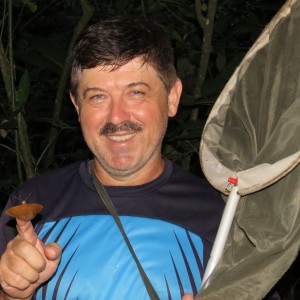
A California native who moved to Honduras in 1993 for the Peace Corps, Robert stayed to make a life there, diving headfirst into the world of tropical birds. He is now considered the country's leading authority on both avifauna and butterflies – a double expert on beautiful flying things. He leads tours for Naturalist Journeys to Panama, Honduras, Texas and Trinidad & Tobago. Robert is the current President of the Pro Nature Honduras Foundation, a small non-profit which promotes nature-based sustainable tourism and environmental education. He is also the co-founder of the Honduran Ornithological Society. He has authored two editions of the "Guide to the Birds of Honduras." He and his partner Olivia hope to publish the "Guide to the Butterflies of Honduras" sometime in 2022. The couple lives in Emerald Valley where they protect 50 acres of rich mid-elevation rainforest and are working to install a nature center with their foundation.
Other trips with Robert Gallardo
-
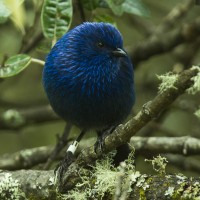 Birds & Mammals of Ecuador's Andes FULL - See our March departure!November 17 - 30, 2025
Birds & Mammals of Ecuador's Andes FULL - See our March departure!November 17 - 30, 2025 -
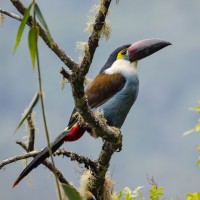 Birding from Bogota A Short & Sweet Colombia TourDecember 4 - 12, 2025
Birding from Bogota A Short & Sweet Colombia TourDecember 4 - 12, 2025 -
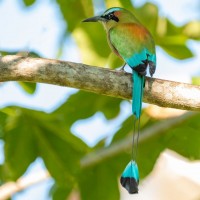 Honduras’ Emerald Valley FULL - Check out Best of Guatemala in January!February 10 - 16, 2026
Honduras’ Emerald Valley FULL - Check out Best of Guatemala in January!February 10 - 16, 2026 -
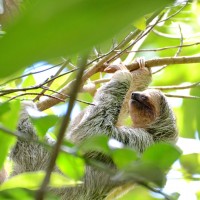 Panama: Birds & MammalsFebruary 20 - 28, 2026
Panama: Birds & MammalsFebruary 20 - 28, 2026 -
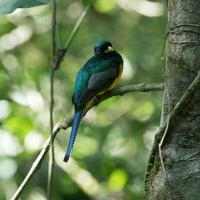 Belize: Three Great LodgesMarch 14 - 24, 2026
Belize: Three Great LodgesMarch 14 - 24, 2026 -
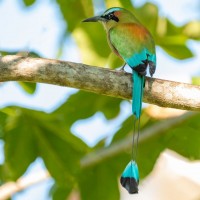 Honduras’ Emerald Valley FULL - See our December departure!May 1 - 7, 2026
Honduras’ Emerald Valley FULL - See our December departure!May 1 - 7, 2026 -
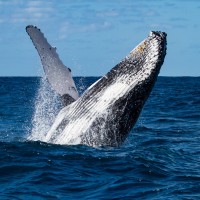 Southern California: Fall Coastal BirdingOctober 3 - 10, 2026
Southern California: Fall Coastal BirdingOctober 3 - 10, 2026 -
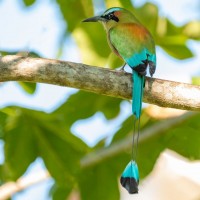 Honduras’ Emerald Valley A Short & Sweet Birding BlitzDecember 1 - 7, 2026
Honduras’ Emerald Valley A Short & Sweet Birding BlitzDecember 1 - 7, 2026
-
Essential Information +
Pace & Protocols +
Packing List +
Suggested Reading List +
Useful Links +
Photo credits: Banners: Elephants (Chuck Paden), Shoebill (Peg Abbott) Thumbnails: Great Blue Turaco (Peg Abbott)



